TORONTO (Oct. 2) — A supper–hour radio show that tested the water for a ballsy format change launched here in town 35 years ago: Oct. 2, 1989. Created by Allan Davis, John Rea and Larry Green. Hosted by Bob McCown. Co–hosted by Bill Watters. Produced by Howard Berger. Directed by Rob Cowan. Prime Time Sports evolved into the longest–running and most–influential radio program in Canadian history, enduring until June 21, 2019, when McCown announced — to the astonishment of the industry — it would be his final show. Ending a remarkable run of 29 years, eight months and 19 days. Try matching that in today’s world, so dominated by social media.
These events, for me, occurred more than half a lifetime ago. Yet, the memories remain vivid. My radio career had started just 16 months earlier (May 1988), so this was a gargantuan step alongside people who were already legends in the business. Just look at the newspaper ad (below) from August/September 1989. McCown had returned to radio after a successful stint with Global TV, at which he and Mark Hebscher created Global Sportsline, a half–hour–long highlight show that aired at 11:30 p.m. (Hebscher and I would later spend a couple of years together on the Leafs beat, as he became Joe Bowen’s radio analyst in the mid–1990’s). Speaking of Bowen, he and Bill Watters were entrenched as the Leafs radio broadcast crew. As were Tom Cheek and Jerry Howarth with the Blue Jays. Don Cherry and Brian Williams were at the apex of the sports media chain — Cherry for his wildly popular Coach’s Corner on Hockey Night In Canada; Williams for becoming, at CBC, the greatest sports–TV host in Canadian history. There was Scott Ferguson, who had grown synonymous with listeners at CJCL AM–1430 for his afternoon–drive sportscasts. And, Ken Kirkley, who covered the ponies for the radio station. Dropped, somehow, into this pantheon of broadcast behemoths was me, the sophomore pisher. To this day, I doubt I belong amid such elite company. But, I certainly had not earned my media wings in October 1989. It was, therefore, a privilege and invaluable learning experience to be the first producer of Prime Time Sports alongside McCown and Watters.
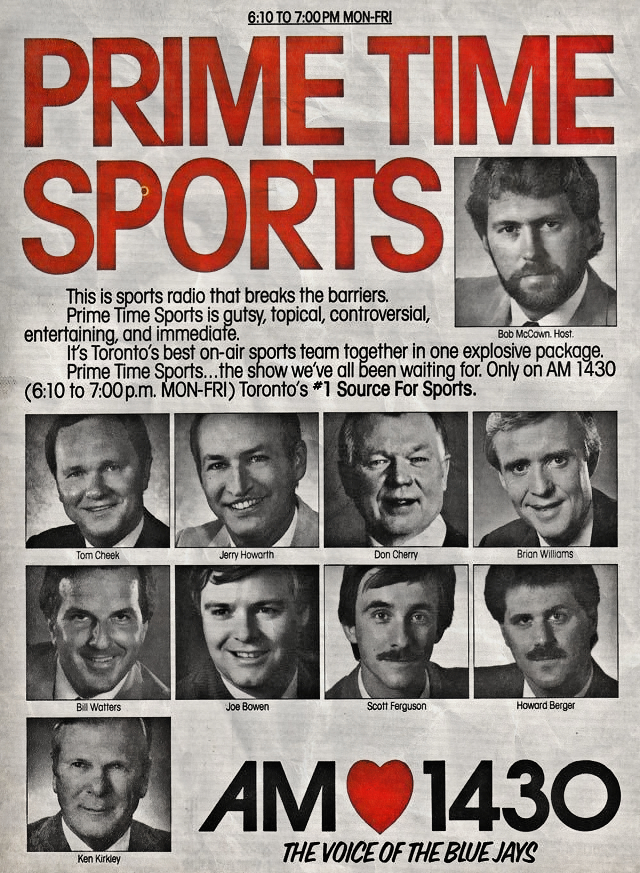 The initial format of the show, as indicated by the above ad, included four segments covering 50 minutes (6:10 to 7 p.m.). The program aired only in Toronto. Several months in, it became evident that Mondays were a comparative wasteland. Nothing big, it seemed, ever happened at the start of the week and many of the weekend storylines had been covered. So, we launched what became known as the Monday Roundtable, in which two outside members of the media joined Bob and Bill in studio for chatter and debate. I remember our first three pairings: Milt Dunnell and Ron MacLean; Steve Simmons and Jim Hunt; Wayne Parrish and Brian Williams. MacLean, who was still relatively new to the Toronto market (he took over as host of Hockey Night In Canada from Dave Hodge three years earlier, in October 1986), came up to me one night at Maple Leaf Gardens and said “Howard, how am I going to argue with Milt Dunnell, the dean of sports writers in Canada? How can I show him irreverence?” I just smiled at Ron and said “oh… you’ll see.” The next week, after appearing on the Roundtable with Dunnell, Ron wobbled out of the studio with dark rings under his eyes. Ol’ Miltie hadn’t become the dean of sports scribes (at the Toronto Star) by accident. Or, by shunning conflict. He ambushed MacLean on the air like a Komodo Dragon.
The initial format of the show, as indicated by the above ad, included four segments covering 50 minutes (6:10 to 7 p.m.). The program aired only in Toronto. Several months in, it became evident that Mondays were a comparative wasteland. Nothing big, it seemed, ever happened at the start of the week and many of the weekend storylines had been covered. So, we launched what became known as the Monday Roundtable, in which two outside members of the media joined Bob and Bill in studio for chatter and debate. I remember our first three pairings: Milt Dunnell and Ron MacLean; Steve Simmons and Jim Hunt; Wayne Parrish and Brian Williams. MacLean, who was still relatively new to the Toronto market (he took over as host of Hockey Night In Canada from Dave Hodge three years earlier, in October 1986), came up to me one night at Maple Leaf Gardens and said “Howard, how am I going to argue with Milt Dunnell, the dean of sports writers in Canada? How can I show him irreverence?” I just smiled at Ron and said “oh… you’ll see.” The next week, after appearing on the Roundtable with Dunnell, Ron wobbled out of the studio with dark rings under his eyes. Ol’ Miltie hadn’t become the dean of sports scribes (at the Toronto Star) by accident. Or, by shunning conflict. He ambushed MacLean on the air like a Komodo Dragon.
“See, Ron, told you it wouldn’t be an issue,” I grinned as the Hockey Night host stumbled toward the elevator.
As mentioned, Prime Time was created as a trial balloon for CJCL AM–1430 to become the first all–sports radio station in Canada. If Prime Time succeeded, artistically and financially, the plan was to ditch music and go all sports within three years. When I joined the radio station, the daytime format was known as the “Music of Your Life.” Or, as we often joked, the “Music of Your Great–Grandmother’s Life.” It was big band and early rock from the 1950’s and 60’s. Our program director, Jim Kidd, possessed an unparalleled vinyl–music collection. It was only at night that we offered sports programming — the Blue Jays and Maple Leafs games, and McCown hosting a show called Talking of Sports in which he talked… sports. It was a call–in show that preceded and followed the live baseball and hockey. On nights when the teams were idle, Bob would carry the full 7–11 p.m. slot. It worked well.
Watters, whom we called Wilbur, made his name as a successful hockey agent, initially as an underling to Alan Eagleson; later partnering with Rick Curran to form Branada Sports. He sold his shares in the agency to Philadelphia–based Curran and turned full time to radio. CJCL had hired me as a glamorized gopher, schlepping around with the station’s microphone–flash. Management even allowed me to talk on the air (which was particularly helpful once I began covering the Leafs). In 1988, the ultra–lucrative Blue Jays radio rights were coming up. CJCL had been with the club since it joined the American League for the 1977 baseball season. But, now, there was much competition, including the giant Standard Broadcasting, which owned CFRB–1010, a booming signal that covered most of Ontario and western New York. By comparison, the AM–1430 signal was a foghorn. So, the Blue Jays would clearly reach a bigger audience with CFRB. Still, the ball club, under president Paul Beeston, had developed loyalty with CJCL and wanted to remain a partner. Among the Blue Jays’ requests was that the radio station intersperse sports programming throughout the day, not just after 7 p.m. Enter the gopher and his mike–flash. One of my early assignments involved covering a Mike Tyson fight in Atlantic City. Not from the venue… but among several thousand on closed–circuit TV at the O’Keefe Centre (now Meridian Hall) in downtown Toronto.
Tyson wiped the canvas with poor Michael Spinks and I joined our morning host, Keith Rich, the following day to discuss the near–homicide. I also started to handle weekend sportscasts at the top of the hour — Saturdays and Sundays from 8 a.m. to 1 p.m. Once Prime Time came about, I produced the show alongside my reporting duties.
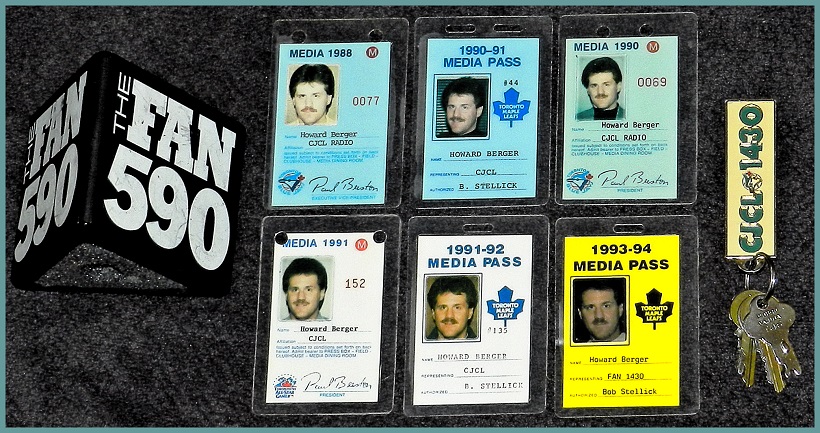
In fact, the two were immediately intermingled. One day after our first show, I flew to San Francisco to cover Games 1 and 2 of the 1989 American League Championship Series between the Blue Jays and Oakland A’s. It was a great opportunity to provide listeners up–to–date baseball info from the Oakland Coliseum. Given we had the radio rights (retaining them after the 1988 challenge from Standard), I could use our game microphones in the visitors’ broadcast booth. We showed, right away, how Prime Time could be a vehicle for instant and breaking news; there was nothing bigger, in 1989, than a Blue Jays playoff series. I remember how Hall–of–Famer Rickey Henderson embarrassed the Blue Jays by running against them at will. Poor Ernie Whitt, the Toronto catcher, had no hope of throwing out the speedy Henderson. As a result, Oakland easily prevailed in the first two games at home. Back at SkyDome for Game 3, I held a wireless microphone at field level during batting practice. At one point, I noticed Henderson standing alone behind the batting cage. He hadn’t spoken since after Game 2 at the Coliseum. So, I swallowed hard and wondered if he had a few moments for a live radio interview — fully expecting to be shoed away. “A live interview?” he pondered aloud. “Sure.” I had McCown throw to me and I asked Henderson about his single–handed destruction of the Blue Jays in Oakland. Rickey couldn’t have been more accommodating or straightforward. It was a wonderful and fulfilling moment in the early days of Prime Time Sports.
As many of you know, McCown grew Prime Time from a local entity into a three–hour colossus simulcast across the country on radio and TV by Sportsnet. When Watters left the show in 1991 to become assistant general manager of the Leafs, Jim (Shaky) Hunt took his place. Later on, when McCown briefly went to the morning hours, the fast–rising Dan Shulman moved in as host of Prime Time. McCown returned to afternoons when Shulman left (in January 1995) to become voice of the Blue Jays on TSN (with Buck Martinez). Prime Time became the signature program of The FAN–1430 when Canada’s first all–sports format launched on Sep. 4, 1992. In February 1995, Telemedia Broadcasting Inc. of Montreal (which owned our station) purchased the stronger AM–590 signal and moved The FAN down the dial. There’s never been anything close to Prime Time Sports in the history of Canadian media. To have been a small part of the show at the outset will always remain a highlight of my 23 years in radio.
WHAT THE PUCK? — A RUBBERY REVIEW
A small part of my hockey collection, yet some interesting items. Follow along with me…
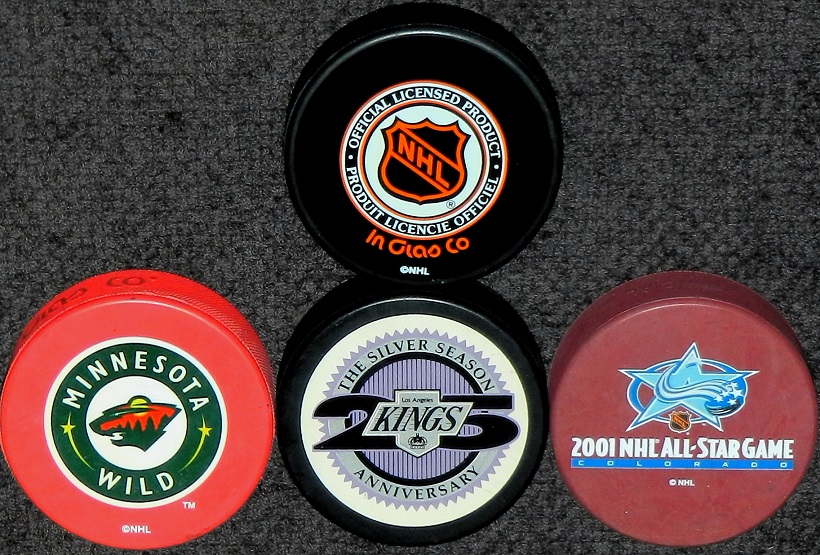
MINNESOTA (LEFT) RETURNED TO THE NHL IN 2000–01, SEVEN YEARS AFTER THE NORTH STARS RELOCATED TO DALLAS. IN 1992, THIS LOS ANGELES KINGS PUCK (MIDDLE) CAME WITH A VIDEO ON THE FIRST 25 YEARS OF THE FRANCHISE WHICH I PURCHASED AT THE LOS ANGELES FORUM. AND, IT WAS ALWAYS FUN SPENDING TIME IN DENVER. AS I DID WHILE COVERING THE 2001 NHL ALL–STAR GAME AT THE PEPSI CENTER (NOW BALL ARENA).

I REMEMBER A LEAFS TRIP JUST AFTER MY SON (SHANE) WAS BORN: TO SAN JOSE, PHOENIX AND COLORADO (DEC. 17–21, 1996). THE COYOTES WERE IN THEIR FIRST YEAR AFTER RELOCATING FROM WINNIPEG. AND, THE PUCK (LEFT) CAME FROM THAT LEAFS VISIT TO THE AMERICA WEST ARENA. IN FEBRUARY 2000, TORONTO HOSTED THE NHL ALL–STAR GAME FOR THE FIRST TIME SINCE JANUARY 1968. IN THE FIRST FULL SEASON OF THE AIR CANADA CENTRE (NOW SCOTIABANK ARENA). LOVED THE LOGO. ATLANTA REJOINED THE NHL IN 1999, 19 YEARS AFTER THE FLAMES DEPARTED FOR CALGARY. THE THRASHERS (PUCK AT RIGHT) PLAYED AT PHILIPS ARENA FROM 1999–2000 TO 2010–11.
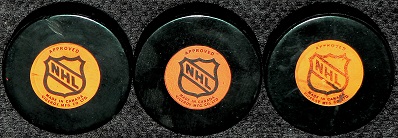
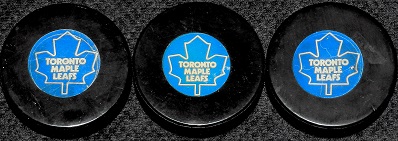
ACTUAL GAME PUCKS CAUGHT AT MAPLE LEAF GARDENS IN THE 1970’s. I REMEMBER TWO: A ZINGER THAT STRUCK THE BRICK WALL BEHIND THE NORTH GOAL AT THE GARDENS AND CARROMED OFF THE BACK OF MY HEAD. I WAS IN RINK–SIDE RED SEATS ON MY 14th BIRTHDAY (FEB. 3, 1973) WHEN ANDRE BOUDRIAS OF VANCOUVER FIRED THE OFFENDING SHOT. AS I RUBBED MY ACHING NOGGIN, THE NICE MAN WHO RETRIEVED THE PUCK OFFERED IT TO ME. WHAT A BIRTHDAY GIFT! THE OTHER PUCK ARRIVED ON MAR. 24, 1975 WHEN THE LEAFS WERE PLAYING THE CALIFORNIA GOLDEN SEALS. I WAS IN THE SOUTH REDS, BEHIND AND TO THE RIGHT OF THE GOAL, WHEN A DEFLECTED SHOT HIT ME IN THE CHEST. PICTURED, ABOVE, ARE THE FRONT AND BACK OF MY LEAF GAME PUCKS FROM THE EARLY–70’s.
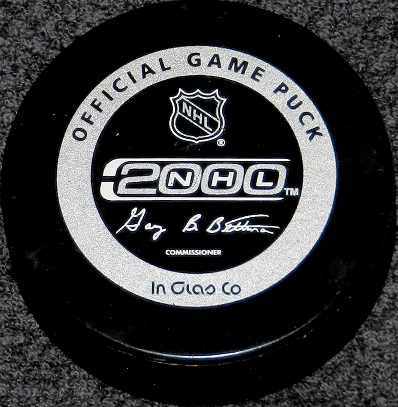
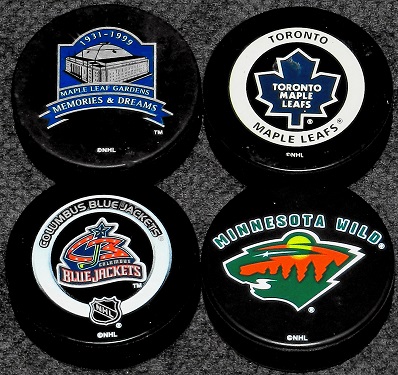
FRONT OF AN OFFICIAL NHL GAME PUCK (LEFT) AT THE END OF THE 20th CENTURY. CLOCKWISE AT RIGHT: PUCK FROM THE FINAL SEASON AT MAPLE LEAF GARDENS (OCTOBER 1998 TO FEBRUARY 1999); BACK SIDE OF THE OFFICIAL LEAFS GAME PUCK FROM 2000; THE NHL EXPANSION TEAMS OF 2000–01 (MINNESOTA WILD, COLUMBUS BLUE JACKETS).
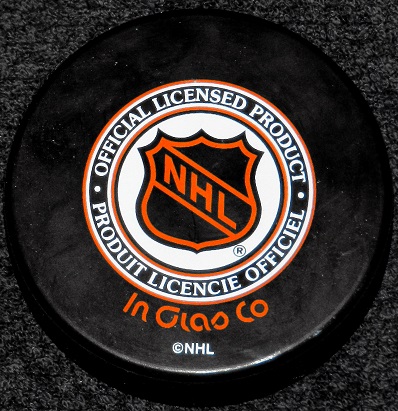

OTTAWA RE–ENTERED THE NHL IN 1992–93 AFTER AN ABSENCE 58 YEARS. THE ORIGINAL SENATORS PLAYED FROM 1917 TO 1934, WINNING FOUR STANLEY CUPS WITH SUCH–LEGENDARY NAMES AS KING CLANCY, FRANK NIGHBOR AND JACK ADAMS. THE CURRENT SENATORS HAVE BEEN TO THE CUP FINAL ONLY ONCE: LOSING TO ANAHEIM IN 2007.
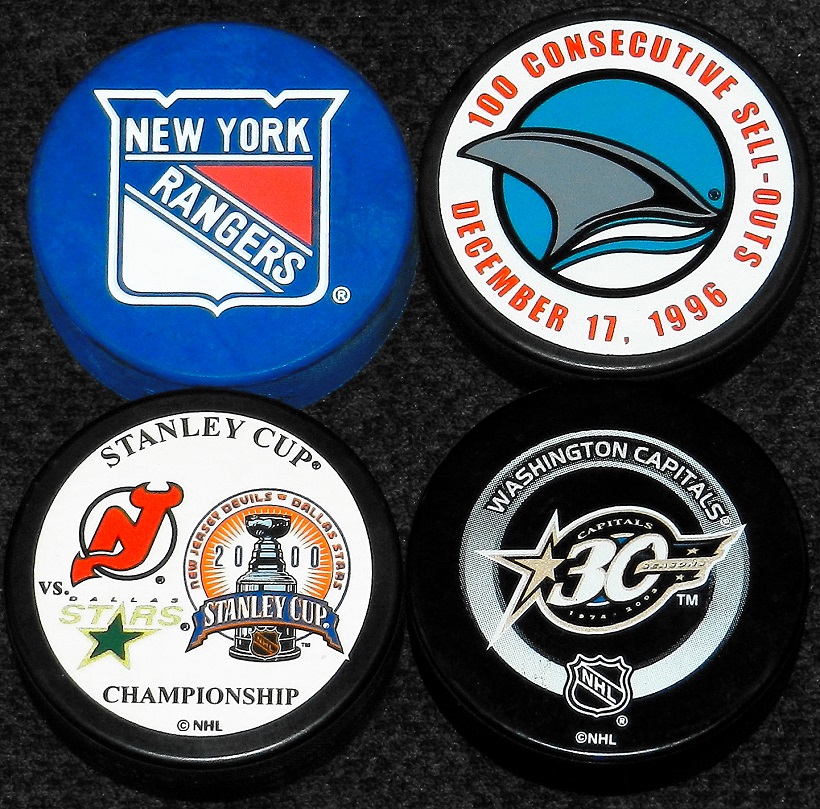
CLOCKWISE FROM TOP–LEFT: A SOUVENIR PUCK FROM THE NEW YORK RANGERS 1994 STANLEY CUP CHAMPIONSHIP; FROM THE SAN JOSE ARENA IN THE SHARKS FOURTH SEASON (1996–97) — THE FIRST WESTERN TRIP FOR THE LEAFS AFTER MY SON WAS BORN; THE 2003–04 WASHINGTON CAPITALS (30th ANNIVERSARY PUCK); THE 2000 STANLEY CUP FINAL, WON IN OVERTIME OF GAME 6 BY JASON ARNOTT OF NEW JERSEY AT THE OLD REUNION ARENA IN DALLAS.
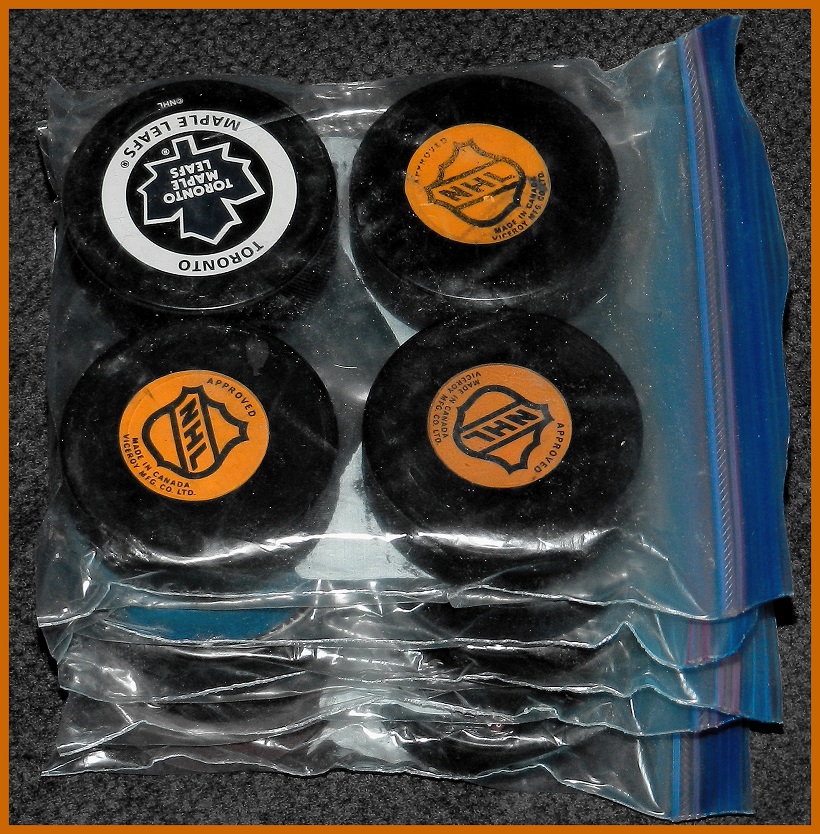
I KEEP MY PUCKS IN AIR–TIGHT PLASTIC BAGS TO PRESERVE THE DESIGNS AND COLORS.
EMAIL: HOWARDLBERGER@GMAIL.COM





























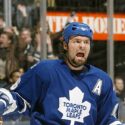
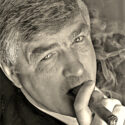
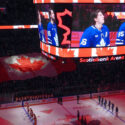

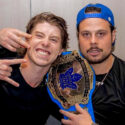
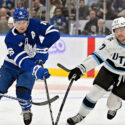
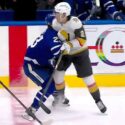
Do you remember your memorable radio interview with legendary Milwaukee Brave pitcher Warren Spahn? I felt sorry for the pain you had to endure that day.
I enjoyed this article but was hoping for some insight into why McCown did the show from Vegas for a while. I recall one show when Saul Korman was at Bob’s place there. I commuted into Toronto from Bronte for years and Prime Time saved me! Bob retired just after I did, perfect timing. Earlier, I lived on Dunfield when the show studio was on Holly and remember seeing Bob having a smoke outside. Great memories.
Bob wanted to live full time in Vegas. He once told me his aim was to become the “Jimmy the Greek of Canada.” But, that’s a long time ago.
I remember finding the early Bob and Wilbur show while working late that fall at our family nursery business. It was smart, engaging and great entertainment, as was Prime Time for all those years.
For me, Overdrive is puerile and weak by comparison so I only listen to occasional segments on podcast.
Rob noted in his comment that Bob refused to do player interviews and I agree completely. There’s absolutely nothing more uninteresting than hearing a hockey player interviewed.
Howard’s impromptu Ricky Henderson interview is an exception, but I doubt those happen very often anymore, and if it was with a hockey player it would have been tap water dull anyway.
The Fan was an excellent station until Rogers bought it. Then it was all downhill after that. I listened all the time back then. Now, not at all.
I remember one evening in the mid 1970s. Bob was doing sportscasts on my afternoon drive show on CKFH. He was moonlighting from his sales job at the station. Talking of Sports debuted at 7pm on nights that there were no Leafs or Montreal Expos game on the air and thus began the genesis of Prime Time Sports. I should probably write a book about CKFH/CJCL of the 70s and 80s. Except for a couple of years at CFTR, I was there for more evolution than anyone else experienced at that radio survivor. I survived more format and personnel changes than most broadcasters ever do and there I was again, “on the board” for that first episode of Prime Time. I was also on the board the first time Dan Shulman was on the air. I was also on the board for Buck Martinez’s disastrous first broadcast too. I was right to want to stay at the station when the format switched to all sports. It’s too bad that my reason for taking the job we negotiated together, was among the first cuts as sports radio became a “money pit” those first couple of years. The real gem of an idea that set Prime Time in full forward motion was when Bob decided that he’d done his last “player interview”. He thought that all of them were redundant and boring. They all said the same thing, over and over again. Like the scene in Bull Durham. “Just say, I go out there, do my best, hope I can contribute to the team and give it my best shot.” Bob pioneered “sports radio” in this country. He found a format and in particular a radio character to play, that lasted a very long time.